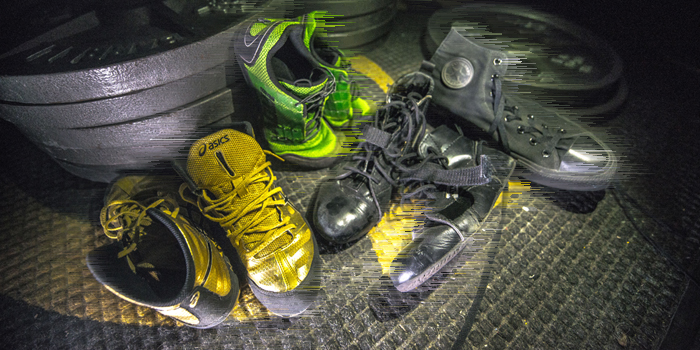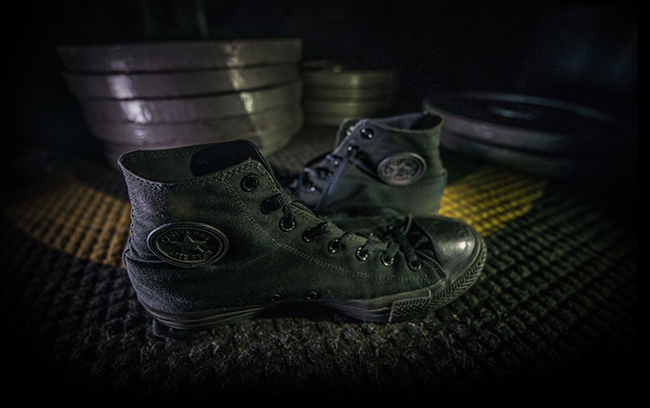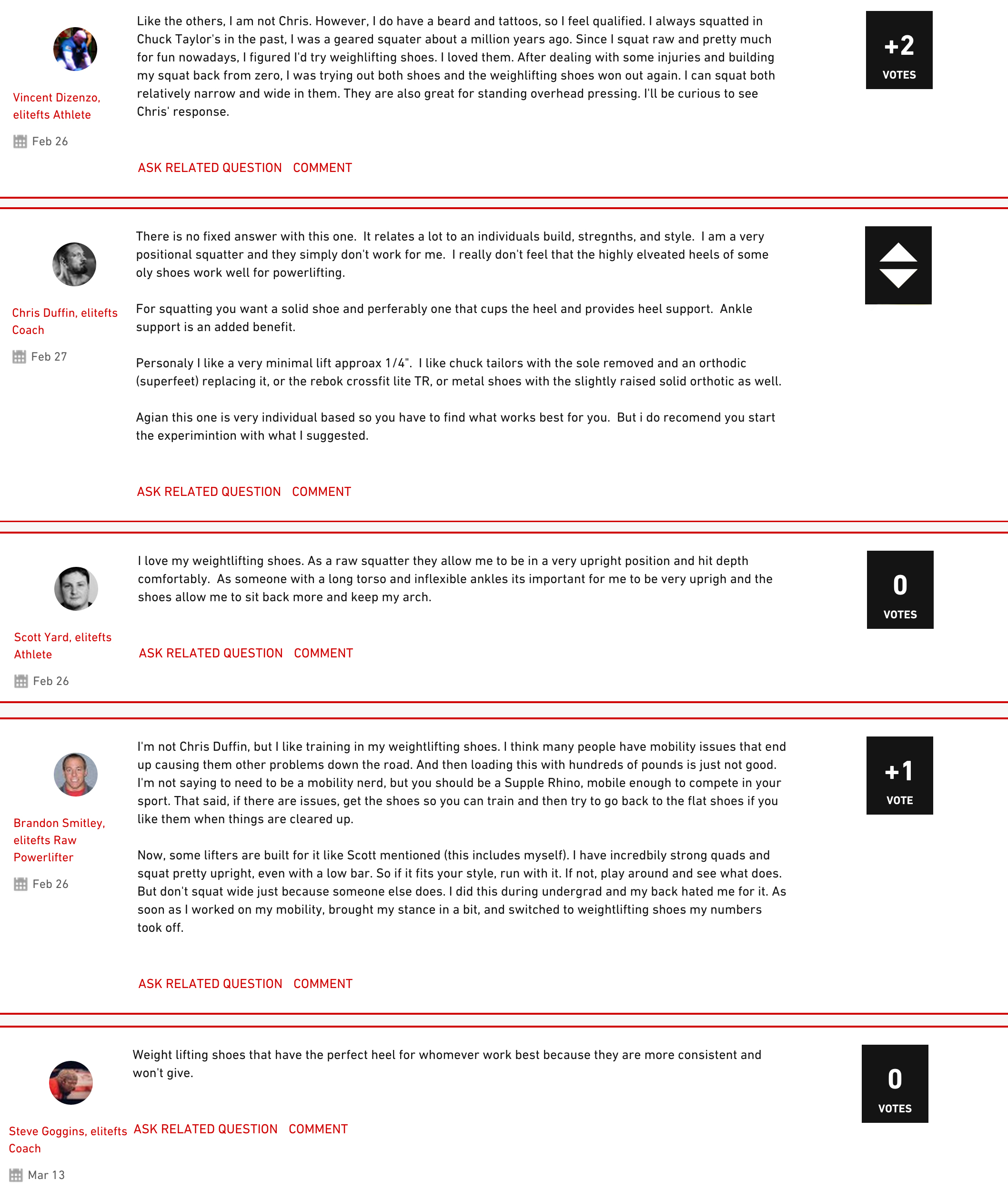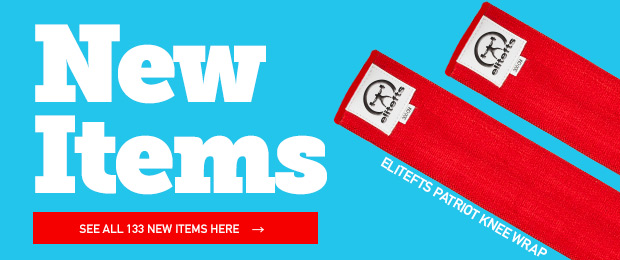
If you ask Joey Smith about lifting shoes, he’s going to give you a pretty simple answer: either you’re strong or you’re not, and the shoes you wear aren't going to change that.
And he's right — the best shoes in the world aren't going to make you stronger. What they can do, however, is alter your ability to physically express your strength.
In fact, multiple studies confirm biomechanical and kinematic impacts of various shoes in performing a back squat. Another study went even further, so as to observe significant differences in peak ankle flexion and erect posture through the wear of weightlifting shoes. That particular study concluded that weightlifting shoes may allow for a safer and more effective squat. According to the research — and to any accomplished lifter — footwear matters for more than fashion.
The most popular shoe amongst powerlifters for the last several decades isn’t quite what someone unaffiliated with the industry would expect: Converse Chuck Taylor All Stars. The flat-soled shoes have been touted as the be-all and end-all of strength training shoes — and for good reason. Hundreds of elite and pro totals as well as all-time world records have been set from lifters who pledge allegiance to Almighty Chucks. Louie even talks about them in his original Westside Barbell Book of Methods.
But what Chucks provide in even-footing they lack in ankle support. This is the greatest complaint made by those who favor a squat and deadlift shoe other than Chucks — the lack of support around the heel. Does this make Chucks a bad choice? Is there a better option? What about weightlifting shoes with an elevated heel?
Heeled shoes are entirely different. Lifters who prefer them often reference improved torso position and an altered center of gravity due to pelvic tilt — Brandon Smitley even hit an all-time world-record squat for the 132-pound weight class wearing heeled weightlifting shoes. Similarly, Steve Goggins considers heeled weightlifting shoes as more consistent due to their ability to withstand a large number of squat workouts without compressing.
I did some digging into the elitefts Q&A for more information from the team and find a definitive answer for the best weightlifting shoe.
Even with the plethora of information I pulled, the answers were unclear. I still had questions. From what I could tell, you should wear a flat shoe or a heeled shoe depending on how you squat, but how do you know which is best for you? The same goes for deadlifting. And what about benching? Why does everyone always talk about squat and deadlift shoes, but seem to not care about benching or other exercises?
I decided to go straight to the source to tackle these questions. I polled answers from all of the members of team elitefts and compared them with one another. The variety of responses I received may surprise you (though it shouldn’t — elitefts athletes have remarkably diverse backgrounds and come from many disciplines).
After talking to the best strength athletes and coaches in the world, I’ve compiled their information into both general and specific rules to follow. Here’s the general consensus, taken from the advice of elitefts’s best.
Shoes to Wear for the Squat
No matter how you squat (wide stance, narrow stance, high bar, low bar, etc.), the most important part of your shoe is the sole. Here’s an exercises to demonstrate why it matters: before you go to sleep tonight, stand on your bed and do a bodyweight squat. Feel unstable? That’s essentially what you’re doing to yourself when you squat with a cushioned sole. For this reason, the number one rule of selecting a good squat shoe is that it have a hard sole. All running shoes and almost all cross trainer are immediately eliminated when following this rule.
If you’re an equipped or wide stance squatter, try Chuck Taylor All Stars, any high-quality boxing shoe (Dave Tate’s favorite because of the grip), or another shoe with flat soles and no cushion. If you feel that Chucks do not offer the ankle support you’re looking for a boxing shoe will be a better fit.
If you are a more quadriceps-based and narrow stance squatter, heeled weightlifting shoes like Adipowers or Adidas Powerlifts are for you. The hard heel slightly changes pelvic tilt and alters your center of gravity, helping you reach depth and stay more upright. For lifters with limited mobility, this can be especially helpful. Watch videos of Brandon Smitley or Scott Yard squatting to see how this looks.
For bodybuilders who want to work the quadriceps and are not overly concerned with maximal weight, wear a heeled shoe. Even an old school work boot like Dave used to wear for squats will work. The shift in body position will help put emphasis on the muscles you’re trying to target.
Winners: Chuck Taylor All-Star’s, Reebok Men’s Crossfit Lite, Any Boxing Shoe, Metal Powerlifting Shoes, Heeled Weightlifting Shoe, Work Boots
Shoes to Wear for the Deadlift
Refer to rule number one from squat shoes: no shoes with a padded sole. Because your feet are the only point of contact between you and the ground, it is important to have a solid and stable foundation.
The infamous Chuck Taylor All Stars are a good shoe for this. The flat sole helps a lifter pull through their heels, allowing for a mechanically advantageous pulling position. Chris Duffin takes this idea even further by removing the rear sole from his deadlifting shoes, forcing him back onto his heel. This isn’t an uncommon tactic, and has been used for many years. Dave Tate often shares a story about how he and other lifters at Westside would have their shoes taken to a shoe shop to have the toe built up.
Like squat shoes, any flat sole will work. Wrestling shoes are amongst the most popular, as are old school deadlift slippers and minimalist shoes such as Merrell Gloves (Skip Hill’s favorite) or Inov-8s.
Winners: Chuck Taylor All-Star’s, Wrestling Shoes, Minimalist Shoes, Metal Powerlifting Shoes, Deadlift Slippers
Shoes to Wear for the Bench Press
Bench pressing is a bit of an anomaly for shoe selection. In the bench press, your body connects to the floor through your feet and through the bench, which abates the flat vs. heeled debate you run into with squatting and deadlifting. Shorter lifters may prefer a heel if they struggle to reach the floor for leg drive.
Almost no powerlifting meets today require a lifter’s heels to stay in contact with the floor during the bench press, making it a bit easier to choose a shoe now than it once was. If you tuck your feet, you want a shoe that allows you to touch the floor with only the balls of your feet. If the shoes are too stiff and won’t allow you to bend at your toes, you’re going to have trouble setting up for optimal leg drive in a tucked-leg position. Take a look at Matt Wenning’s preference of bench shoes. Sandals. These work for Matt because he’s able to bend at his toes and keep the balls of his feet on the floor.
If you do not tuck your feet and choose instead to flare them in front of you or flatly rest them on the floor, you only need to worry about the bottom of the shoe: is it sticky enough? If you look for only one thing in a bench-pressing shoe, make sure the bottom of the shoe adheres to the floor. If you follow that one rule, you’ll have a good shoe.
Winners: Rock Climbing Shoes, Sneakers
What About Other Exercises?
Outside of the big movements covered above, shoe selection really comes down to personal preference and common sense. Any exercise in which your feet are the only connection to the floor will require that you have a flat sole for a stable pressing surface. Conversely, if you’re doing Prowler conditioning, it might be a better time to add a more agreeable shoe than Chucks or weightlifting shoes.
The most important thing I learned, though, is that you can always just go with the Selkow option:
















I'm just wondering, where's the Vibrams love?! Toe shoes are the best!!
When I'm at the training center where I work part time as a trainer I wear either Merrell minimalists or weightlifting shoes when doing O-lifts.
Been telling clients to get rid of the running shoes when lifting for years,,,some do, some don't.
They're listed under the "Winners" for squat shoes. People tend to like them for the same reasons they like Chuck Taylors, but because Chucks are so much more popular, I didn't give special focus to the Crossfit Lites.
Definitely a well-liked shoe, and a lot of people love the 'Toe Box' concept.
Thanks for reading!
If you want to double up and use climbing shoes for strongman events, I'd look for something with a flatter sole, suited for long climbs (some will almost look like a high top Chuck Taylor) and remember that the rubber will work best when warm on a surface it can grip. Climbing shoe rubber in your freezing garage or on carpet won't do much.
Converse should just go ahead and rename them "Chuck Vogelpohl's" and shoot him some royalties.
For Bench Press, I'm still trying to find the ideal shoe. In IPF comps, the feet MUST be flat on the floor at all times - you'll be disqualified if the heel comes off the floor, even for a nanosecond. And because I want maximum leg drive for a strong Bench Press, I want a shoe that grips my foot hard & 'sticks' to the floor & hangs on no matter how hard I try to push myself off the bench. My coach has suggested Adidas Powerlift 3 & I've just ordered a pair. Time will tell if they help or not.